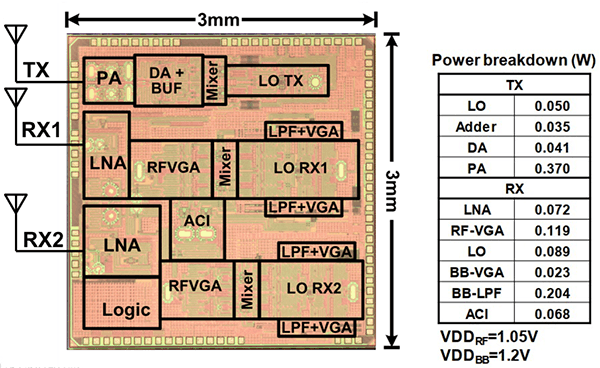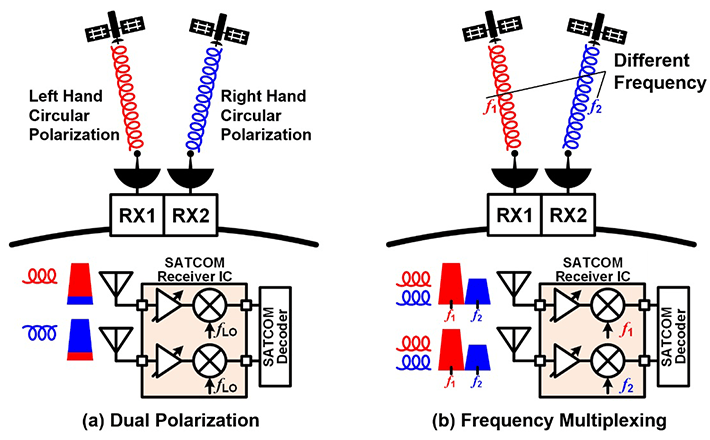Scientists at Tokyo Institute of Technology and Socionext Inc. have developed a novel transceiver for enabling seamless communication between earth ground platforms and satellites in the low, middle, and geostationary earth orbits. Among other things, this transceiver could bring Internet to people in remote rural areas and at sea.

Figure 1. Prototype of the SATCOM transceiver and its power consumption characteristics
The test chip only measures 3 mm by 3 mm.
We live in the information age, where communications technologies have reached unprecedented levels of advancement. Yet, bringing connectivity to remote locations, such as rural areas or the open sea, remains difficult. Satellite communication (SATCOM) is an attractive option for providing data links to such places; but for effective SATCOM, the right equipment must exist both in space and here on Earth.
At the forefront of research to achieve superior SATCOM are scientists from Prof Kenichi Okada's lab at Tokyo Institute of Technology (Tokyo Tech), who have developed a novel transceiver[1] for SATCOM using standard CMOS[2] technology. This transceiver operates in the "Ka band," which, for SATCOM, means a 27-31 GHz frequency range for uplink (ground to satellite) and 17-21 GHz range for downlink (satellite to ground).
Their design carries a variety of features that make it stand out from the competition. On the transmitter (TX) side, a high-quality-factor transformer is employed to achieve efficient power use and high linearity in transmission, which results in lower distortion during transmission. The receiver (RX) side features a dual-channel architecture that unlocks several capabilities.
First, having two RX channels allows for receiving signals from two satellites simultaneously. These signals are received in parallel using either two independent polarization modes or two different frequencies. In addition, the proposed design can perform adjacent-channel interference cancellation; that is, the "contamination" on a signal received in one channel by another signal on an adjacent frequency band is eliminated using information received at the other channel. This strategy increases the dynamic range of the system, thus allowing it to operate correctly even in less-than-ideal scenarios with stronger noise and interference.

Figure 2. Two RX channels support (a) dual polarization and (b) frequency multiplexing
Both the TX and RX perform direct conversion of a signal; that is, the TX directly converts a baseband signal[3] into a modulated signal[4] and the RX performs the inverse process without additional intermediate frequency conversions, unlike the more commonly used superheterodyne receivers. This makes the overall complexity, size, and power consumption of the transceiver considerably lower.
The scientists created a prototype chip to test the actual performance of their design when using all the modulation schemes regulated by the SATCOM DVB-S2X standard. This includes high-order modulation techniques like 64 APSK[5] and 256 APSK, which provide fast data rates.
The performance test results are very promising, especially when compared with other existing SATCOM transceivers, putting this developed novel design on the map. Prof Okada remarks, "Our paper presents the first Ka-band SATCOM transceiver implemented using standard CMOS technology and designed for an earth ground platform communication with geostationary and low Earth orbit satellites."
These orbits are at 35,786 km and 200-2,000 km, respectively. Communicating with satellites that far away from a 3 mm by 3 mm chip is certainly no simple feat.
For years, Prof Okada's lab has been developing various types of state-of-the-art transceivers for next-generation technology, including 5G applications, Internet-of-Things-enabled devices, and low-power Bluetooth communications. This latest transceiver is another piece in the puzzle of enabling seamless worldwide connectedness. "Satellite communication has become a key technology for providing interactive TV and broadband internet services in low-density rural areas. Implementing Ka-band communications using silicon-CMOS technology in particular-is a promising solution owing to the potential for global coverage at low cost and using the wide available bandwidth," Prof Okada says.
Let us hope that the efforts of these Tokyo Tech researchers help more people benefit from instant communication in the current information era.






